My husband is always pestering me, “Hey, you’re a historian of science—why don’t you study the history of mycology?” Or, “You want to write about science, right? The study of mushrooms is pretty cool, why don’t you write about mushrooms?”
Well, alright. After all, these elusive, mysterious fungal reproductive organs brought us here to Borneo, it seems only fair that I finally write something about them.
There you are, then, that’s something about mushrooms: A mushroom is the reproductive structure, also called the fruit body, of a fungus. Most fungi that you or I would recognize are, like plants, multicellular organisms with stiff outer cell walls—that’s the part that’s hard for our bodies to digest when we eat uncooked vegetables or mushrooms. Like all multicellular organisms, the work of living is divided up between different cells. Most of the “body” of a fungus exists where we cannot see it. That is the mycelium, a filamentous structure that grows underground or through a decaying log—wherever the fungus resides. It absorbs nutrients, exchanges gases, and expands the fungus’ territory; it’s in charge of all the stuff of daily life. But when a mushroom appears aboveground, it’s time for reproduction.
This is why mushrooms are so important to mycologists. Like a lot of other organisms on this planet, reproductive systems provide a lot of clues about the identity of an organism, how it’s related to other organisms, and its evolutionary history. One of the really wonderful (some would even say seductive) things about biology and evolutionary theory is its intuitive appeal, and this concept is no exception! If evolution is a matter of survival and reproduction over thousands of generations, then it makes a lot of sense that many biological questions and problems would revolve around understanding how cells and organisms produce the next generation. For example, if you have ever taken a course in botany, you know that basic plant identification begins with the reproductive organs, the flowers: the number of petals and the arrangement of the pistils and stamens, which are the flower’s sex organs, these are the keys to identifying flowering plants.
Another level of “identification” is the attempt to understand what a species is. This is a knotty issue, both philosophically and practically, but an inability to interbreed is used by many as a basic criterion for separate species. If two organisms cannot mix their genes to produce viable offspring, for whatever reason—it could be physical, behavioral, or genetic—they belong to two different species. You get the picture: sex is biologically important, thus biologists are often focused on reproductive organs.
In a practical, day-to-day sense, then, my husband spends a lot of time looking at fungal sex organs. And what does he see? In order to show you, I am going to take you for a walk in the muddy wellies of a field mycologist.
Here we are in Borneo, exploring a tropical rainforest. We are on the opposite side of the biological universe from the boreal forest of northern Minnesota, where my husband Bryn grew up. So how does Bryn know where to look for mushrooms? In a sense, the answer is: he looks everywhere. It’s true, and anyone who knows him will confirm it, he never stops looking! However, like any mycologist, my husband usually has some sense of where to head first…
As you walk through the rainforest, remember that mushrooms do not live in isolation. While much is made of the work that fungi do in decomposing dead forest debris (and certainly they are amongst the most important decomposers in the forest), a lot of fungi are not decomposers. Instead, many fungi live in symbiosis with plants, called a mycorrhizal association. To put this symbiosis in perspective: If all of the fungal partners in this marriage were to file for divorce tomorrow, almost all of the forested land in the temperate Northern Hemisphere would be treeless. Luckily, however, a complex exchange of nutrients and water makes this partnership sustaining and beneficial for both sides. Thus, the first thing Bryn looks for is a type of forest. Wherever we go, he has already learned as much as he can about the kind of trees we will find, and he knows which ones are most likely to have the kind of symbiosis with mushrooms that he is looking for. Here in Gunung Mulu National Park, we are seeking lowland tropical rainforest giants: the dipterocarps. This is a group of trees that are especially abundant and diverse in Asia—and especially here in Borneo.
Of course, because these trees are gargantuan, there’s an added difficulty: you can’t see the leaves, they are too high up! And many of the leaves in the tropical forest look very similar, so they are difficult to identify anyway. As Bryn has said, to be a mycologist in the tropics, you practically have to be a botanist as well—and, indeed, he spends a lot of time trying to identify trees and detect patterns of association between trees and mushrooms.
For your purposes, though, just start by looking for some very big tree buttresses, those huge wedge-shaped roots that tropical trees use to prop themselves up because they are so shallowly rooted. Yep, that means you have to go off the trail, so watch out for pit vipers and toxic, furry urticating caterpillars! Poke around in the crevices between these buttresses and you’re bound to turn up something.
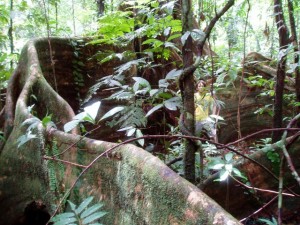
Some mushrooms can be identified morphologically, that is, by examining their appearance, whether with the naked eye or under a microscope. There are all sorts of features that turn both the beautiful and the boring of the fungal world into recognizable species. Where you or I just see cap and stem and gills, Bryn makes fine distinctions. There’s an overall sense of the form of the mushroom that it takes years to develop.
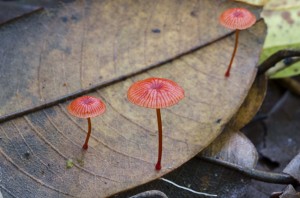
Before I went for a walk (or many walks, that is) in the woods with a mycologist, I wasn’t really aware of the sculptural quality of mushrooms. Now I have an appreciation for the beauty of their overall shapes and textures. But Bryn’s brain is like a code reader. From a distance he can judge if that tiny little thing on the log is a Marasmius or Mycena, based on the shape of the pileus (the cap), the width and bow of the stipe (the stem), and other general impressions that he probably cannot even articulate—the tacit knowledge that the scientist gains from years of direct experience.

Take a closer look now. Is the surface of the pileus velutinous (velvety) or glabrous (smooth)? Is it rugulose (wrinkled), pitted, or cracked? Better yet, it could be glutinous and covered in slime.
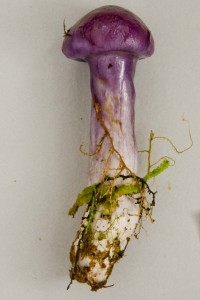
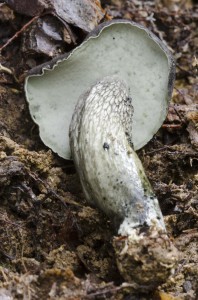
Does the stipe have any interesting features, like a finely netted reticulation or patchy raised “scabers”? You might break a little piece of the pileus off with your fingernail and try to peel the top surface off—whether it peels easily is yet another field character.
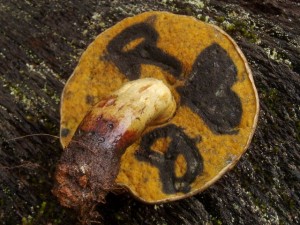
Look under the pileus, and if there are gills, make a small slice through them with your knife: Does a white, yellow, red, or blue latex ooze out? Does it change color once the air oxidizes it? Keep an eye for color changes on the flesh of the mushroom as well. Is the pileus or stipe bruised where you have held the mushroom? Bluing reactions can be especially impressive, as you can see below.

Or perhaps it looks like a sponge, like you see on the left. Microscopically, the underside of the pileus is one of the most important parts of the mushroom, because this is where the reproductive cells are located. The sponge you see (look—a well-fed beetle larva just crawled out of one of the pores!) is made up of thousands of little tubes, packed in together. Like the gills, these tubes exist solely as the means to spread the mushroom’s spores. You may see a tint of color on the gills or pores here that hint at the color of the spores, which can be a very important character. The spores themselves can be extremely beautiful, but you won’t get a really good look at them until you are back in the lab with your microscope.
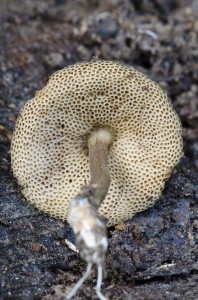
Mushrooms may also identified using chemical characters. Some chemical tests must be done in the lab with droppers full of reagents that turn different mushrooms different colors; but there are plenty of chemical characters that can be tested right here in the field. The nose knows—and Bryn has an impressive nose, in both form and function! Does the mushroom smell raphanoid (like a radish or watermelon rind)? Or perhaps it smells like camphor or almonds or even like rotting flesh? Some mushrooms must be tasted to be understood, so beware the mycologist that hands you a tiny piece of fungus to taste in the field. It’s unlikely that he is trying to poison you, but he might be giving you a chunk of an acrid Lactarius that tastes as if you are chewing some especially hot peppercorns!
As you have learned, workaday mycology begins outside, in direct contact with the natural world. The attention that you paid to the forest around you and the detailed observations that you have made of the very fine Tylopilus that you found will pay off in dividends in the future. First, there is a cumulative benefit to be gained from today’s time in the forest. This is the practice of natural history: You draw continually from the knowledge that you’ve gained in past experiences in nature and in your study of others’ work, and you synthesize that knowledge with your immediate experience of the world around you today.
But what’s next for today? Fortunately, Bryn’s ready with a snappy mycological aphorisms for just this kind of occasion: Flash it, Smash it, and Dry it.
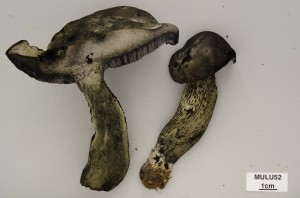
“Flash it” is probably obvious: You must photograph your mushroom both before and after you collect it. Get a nice picture in the field, showing the substrate on which it was growing, and later take a more artificial photo against a neutral background, to record color and scale, and morphological details.
“Smash it” is Bryn’s method of DNA collection. Once upon a time we carried tiny little plastic tubes with preservative liquids into the field, into which we would plunge a fragment of each mushroom’s gills or pores. Now the very same reproductive tissue gets smashed into a fancy kind of paper that preserves the DNA in a much more convenient form. Bryn has even made a very informative video of this method.
That last step, “Dry it,” kind of ruins the rhyme, but there’s no way around it, you can’t change what happens in a food dehydrator. Before that lovely Tylopilus nigerrimus starts to deliquesce, better dry it out as soon as possible.
Now that you have flashed, smashed, and dried your mushroom, you’re ready to take your impressive knowledge of that mushroom’s natural history into the laboratory. Scientists who work with DNA may be derided as “gene jockeys” when they have a myopic focus on DNA, at the expense of seeing the whole organism. But you are already well on your way to becoming a natural historian and I know you won’t lose sight of that whole living mushroom and its associated tree when you finally get a peek at its DNA.
7 thoughts on “A day in the life of a field mycologist.”
Comments are closed.

Great post, Rachel! Now I have a go-to reference whenever anyone asks me what my brother does 🙂 Up until now, I’ve only been able to say “He studies mushrooms.”
Great stuff, I really enjoyed reading it. Nice to see your updates on facebook as well, Borneo sounds exciting!
Wonderful! The life of a field mycologist has never sounded so enticing. Also, nice use of the second person–that really sucked me into this post!
Thanks so much for the comments, everyone! Josiah, you must be heading to Ecuador soon too, for some of your own tropical adventures.
Rachel, I really enjoy you informative and delightful writing that us common folk can appreciate while maintaing your scientific integrity, it is especially fun when I know the characters!!
very helpful Rachel! i’ll volunteer myself to talk about mushroom ( mulu’s mushroom) on the tuesday morning class. great pics too!
Awesome, Floria! Someday, hopefully, Bryn will take part in making a handy Mulu Mushroom guide that will be much more helpful than my posting 🙂